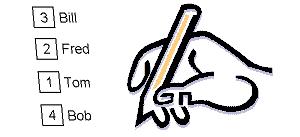
Adoption of instant runoff voting within the US
Voters in Ferndale, Michigan amended the city charter in 2004 to allow for election of the mayor and city council by instant-runoff voting. On March 1, 2005, voters in Burlington, Vermont voted to amend their city charter to use instant-runoff voting. Suggested by a recent version of Robert's Rules of Order, instant-runoff voting is used in the United States for some non-governmental elections, including student elections at some major universities, including most notably the ASUC at the University of California, Berkeley. This issue rose to attention in the United States in the 2000 election. Supporters of Ralph Nader who nevertheless preferred Democrat Al Gore to Republican George W. Bush found themselves caught in a dilemma. They could vote for Nader, and risk Gore losing to Bush, or, they could vote for Gore, just to make sure that Bush is defeated. It has been argued that Bush won solely due to the "spoiler effect" of Nader supporters in either Florida or in New Hampshire. Notable supporters include Republican U.S. Senator John McCain, 2004 Democratic presidential primary election candidates Howard Dean and Dennis Kucinich, and consumer advocate Ralph Nader. The system is favored by the United States Green Party and the United States Libertarian Party, as a solution to the "spoiler" effect third-party sympathizers suffer from under plurality voting (i.e., voters are forced to vote tactically to defeat the candidate they most dislike, rather than for their own preferred candidate). In order to increase awareness of the voting method and to demonstrate it in a real-world situation, the Independence Party of Minnesota tested instant runoff voting by using it in a straw poll during the 2004 Minnesota caucuses (results favored John Edwards). Also, the Green Party of Minnesota conducts an annual poll of Minnesota State Fair attendees, where each person ranks their preferences for fair food to better understand how instant runoff voting works in a real-world situation. Instant runoff voting was adopted for mayoral races in Ann Arbor, Michigan in 1974 after a successful ballot initiative sponsored by the local, left-wing Human Rights Party; however, the process was used only for the 1975 mayoral election. In March 2002, an initiative backed by the FairVote - The Center for Voting and Democracy passed by referendum making instant runoff voting the means of electing candidates for the Board of Supervisors and most citywide offices in San Francisco. It was first used in that city in October 2004 when YouthVOTE, an election held throughout San Francisco's public schools which elected the SF school board's student delegate, [1] after that it was used in the November 2004 supervisoral races. (Note: The San Francisco Department of Elections prefers the term "Ranked Choice Voting" because "the word 'instant' might create an expectation that final results will be available immediately after the polls close on election night.") Voters in Ferndale, Michigan and Berkeley, California amended their city charters in 2004 to allow for election of the mayor and city council by instant-runoff voting. On March 1, 2005, voters in Burlington, Vermont voted to amend their city charter to use instant-runoff voting. In its first use, on March 7, 2006, state representative Bob Kiss (Progressive) [2] was elected mayor. When the "first choice" votes were counted, Kiss had 39%; the next highest candidates had 31% and 26%. In the November 8, 2005 election, 84% of 1582 voters in Takoma Park, Maryland voted to adopt instant runoff voting for the city, and the city council in 2006 voted unanimously to amend its charter to use instant runoff voting for future elections for the city council and mayor. North Carolina adopted legislation in 2006 to use instant runoff voting for certain vacancy elections and to use it on a pilot basis in up to 10 cities and 10 counties in 2007-2008. Proposals not yet adoptedIn September 2003, an amendment to the California State Constitution was proposed (SCA 14) with wide-ranging goals of election reform, including ranked-choice voting for statewide offices. Activists in the state of Washington have been urging adoption of instant-runoff voting there for several years. An initiative seeking ballot access in 2005 failed to garner enough signatures. The city of Vancouver, Washington has voted to adopt instant-runoff voting, but the state legislature has yet to enact enabling legislation. On May 26, 2005, Representative Cynthia McKinney introduced H.R.2690, the "Voter Choice Act of 2005," which requires the use of Instant Runoff Voting for General Elections for Federal Office. The bill has no co-sponsors, and has sat without action in the U.S. House Committee on House Administration since the date of introduction. |
 In March 2002, an initiative backed by the Center for Voting and Democracy passed by referendum making instant runoff voting the means of electing local candidates in San Francisco. It was first used in that city in Fall of 2004. (Note: The San Francisco Department of Elections prefers the term "Ranked Choice Voting" because "the word 'instant' might create an expectation that final results will be available immediately after the polls close on election night.") The new system did not work as well as was hoped due to software and logistical difficulties; the results took several days to produce definitive results.
In March 2002, an initiative backed by the Center for Voting and Democracy passed by referendum making instant runoff voting the means of electing local candidates in San Francisco. It was first used in that city in Fall of 2004. (Note: The San Francisco Department of Elections prefers the term "Ranked Choice Voting" because "the word 'instant' might create an expectation that final results will be available immediately after the polls close on election night.") The new system did not work as well as was hoped due to software and logistical difficulties; the results took several days to produce definitive results.
